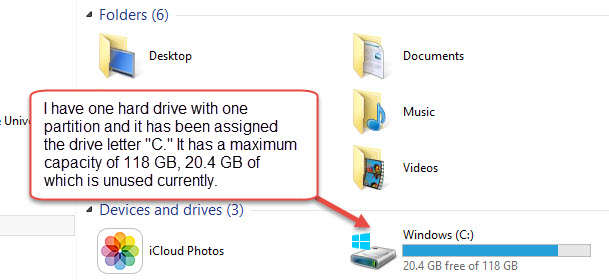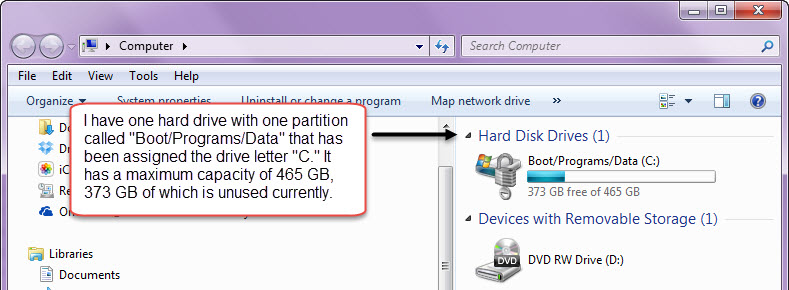Difference between revisions of "Checking hard drive capacity and folder size on your PC laptop"
| Line 45: | Line 45: | ||
*[[PC laptop backup FAQ]] | *[[PC laptop backup FAQ]] | ||
*[[PC laptop backup]] | *[[PC laptop backup]] | ||
| − | *[[Receiving your laptop | + | *[[Receiving your laptop]] |
*[[Student Laptop Distribution Training]] | *[[Student Laptop Distribution Training]] | ||
[[Category:PC]][[Category:Laptop Exchange]][[Category:Backup]] | [[Category:PC]][[Category:Laptop Exchange]][[Category:Backup]] | ||
__NOTOC__ | __NOTOC__ | ||
Revision as of 20:14, 19 April 2018
About this article
This article includes instructions for determining the capacity of the hard drive of a PC laptop provided through the E-Warrior Digital Life and Learning Program. It also covers how to determine the size of folders on your laptop's hard drive. This is useful for routine monitoring purposes and when preparing for an exchange or re-image. It is intended for both students and employees.
Home Folder
The home folder is typically where all your personal school-related files will be stored. It is actually not called Home Folder, it a folder with your StarID located: c:\Users\your StarID. If you want to do a complete backup of your PC, the easiest way is to copy everything in this folder. Note: always check for application specific files that get stored in program folders. See section below to find out how large your home folder is. This will be how much space you need on your backup media i.e., SD Card, network drive, flash drive, etc.
Checking used and free space on your hard drive
Every hard drive has a maximum storage capacity. As you install programs and save files, the drive fills up. To check the maximum capacity, how much space you have used, and how much space you have left, do the following:
In Windows 10
Use the Storage Sense menu to view how much free space you have left on your hard drive. Lynda.com video on Windows 10 Storage Sense
In Windows 8
- Select the 'This PC' tile from the Start page or desktop
- Listed under Hard Disk Drives, you will see all of the volumes (Fig 1)
In Windows 7
- Select Start...Computer or select the Computer icon from the desktop
- Listed under Hard Disk Drives, you will see all of the volumes (Fig 2)
Checking folder size
Basic steps
You can check the size of a single folder in two ways:
- Mouse-over the folder name. The tool tip will usually display the size of the folder. In Figure 3, I am checking the size of my Music folder via the tool tip. It's 2.64 GB.
- With the folder selected, right-click on it and select Properties. in Figure 4, I am checking the size of my Music folder via Properties. It's 2.64 GB.
Checking the size of your Home folder
You can use the two methods above to check the size of your entire Home folder, the one that probably holds all of your school-related and personal files.
- HP 8460w and 8470w: Your Home folder is located at Boot/Programs/Data (C:)\Users\[your StarID]
- HP 840 G1 and G2: Your Home folder is located at Windows (C:)\Users\[your StarID]
Important information about folder sizes
- If the folder size via properties is larger than the result via the tool tip, it's because you have hidden system-related subfolders. This will be evident when you check the size of your Home folder because it includes a large, hidden folder called AppData. Checking the size using properties includes hidden subfolders, whereas the tool tip does not. You do not want to back up hidden subfolders anyway, so your tool tip size will be more relevant. By default, you can't see hidden subfolders. You can unhide them if you wish.
- Sometimes, your tool tip will indicate that the folder size is larger than a certain amount. This means that the function that computes the size for the tool tip was not able to complete the task within the specified amount of time. If this happens, use properties to view the folder size.



